
List of cheerleading stunts
Encyclopedia
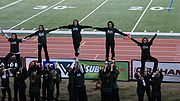
Cheerleading
Cheerleading is a physical activity, sometimes a competitive sport, based on organized routines, usually ranging from one to three minutes, which contain the components of tumbling, dance, jumps, cheers, and stunting to direct spectators of events to cheer on sports teams at games or to participate...
has been previously referred to as building pyramids
Human pyramid
A human pyramid is a type of gymnastic formation in which the participants kneel together in a row or other formation, forming a base for another tier of participants who stand or kneel on their shoulders, backs or thighs. A human pyramid is very difficult to make. In case that the participants...
. Stunts range from basic two-legged stunts to one-legged extended stunts and high flying basket tosses. There are numerous variations of each basic stunt.
A stunt group usually involves up to four bases holding or tossing another cheerleader in the air. In general, all-girl cheerleading stunts usually involve up to four other bases while co-ed ("partner") stunts have only one base (usually male) and his partner (the flyer, usually female). This sport is all about Trust and Communication.
Pyramids are multiple groups of stunts connected aerially by the flyers. This connection may be made in a variety of ways, from a simple linking of hands to having a multi-level pyramid, with the flyers already in the air acting as primary bases for another flyer or flyers on top of them.
Athletes involved
Bases : Cheerleaders that stay on the ground providing the primary support for the flyer during a stunt. Bases should be watching the flyer at all times in the case of a mishap. Also, bases should keep eye contact with each other at all times, so they have an understanding on what to do next. Bases can be male or female, but they are usually the strongest athletes on the squad. The bases are usually two females or one male. Both bases are usually assigned together based on height to create an equal balance for the flyer to perform an action.Main Base : The term main base only applies when doing a one-legged stunt. This base has the majority of the flyer's foot, and the majority of her weight. The main base will be almost directly under the stunt until it is cradled or brought down. In a one leg extension stunt, the main base will lift the toe and heel of the foot to increase stability from moving forwards or backwards. With single base extensions the main base with grip onto the heel of the flyers foot having a nice and stable transition. The main base is the "powerhouse" of one legged stunts because she/he holds roughly 80% of the flyers weight by having their arms extended directly over their head cupping the flyers foot from toe to heel, creating a "floor" for the flyers foot and stability.
Second Base : The term second base only applies when doing a one-legged stunt. The second bases help lift the flyer up into the air and support the flyer's foot. The hand position for the side base can vary depending on preference. The more common placement is to have one hand under the middle of the foot and the other hand on top of the foot for stability. An uncommon option is to have one hand under the middle of the foot and the other hand pushing up on the wrist of the main base to lift from underneath. The side base's hand positioning functions to lift and to stabilize the flyer's foot from shifting from side to side.
Flyer : This is the person that is in the air during a stunt. The flyer must control their own weight by keeping their abdominal muscles tight to stabilize the spinal column while in the air. They also need to lock out their legs. If they don't stay tight, there is a greater risk of them becoming off of their center of balance and falling. They must keep a steady focus on what they are doing. Flyers should be healthy. A strong core and good sense of balance are key qualities for a flyer to possess. Flyers should be extremely flexible and have a slender muscular body. Flyers are typically short and lean people on the team, but other members can act as a flyer depending on their exceptional abilities.
Back (Back Base or Third in some regions) : This is the person standing behind the stunt. They help to position the flyer in the bases hands. They, for the most part, support most of the weight of the flyer. They do so by using their hands to support the flyer's buttocks and ankles, and then push her up into the air. Once in the air, they will hold the flyer's ankles with both hands, pulling the ankles up to loosen the weight of the flyer for the bases and providing support. When the flyer cradles, they catch her under the arms to support the upper back and neck area. If the flyer falls backwards, it is crucial for the back to attempt to catch the head and shoulders to prevent head/spinal injury. Because of the back's responsibilities, they are generally the tallest members of the team.
Front Spot : This is the person standing in front of the stunt facing the back base preventing the flyer from falling forward. The front spot often provides extra support to wrists of the bases in higher stunts such as extensions. The front spot has somewhat of the job of the back spot. Though the front spot is there, a flyer should never fall forward, rather backwards. There is not always a front spot in a stunt, and many squads only use front spots for basket tosses because it helps to throw straight upwards. Front spots are typically the smaller weaker of the squad, who have not been trained or are not flexible enough to fly, and are also not at the right height and strength to side or back.
Additional (hands-off) Spotter : This person does not actually touch the stunt unless something goes wrong. The free standing spot can stand behind, in front, or beside the stunt. Eyes stay on the stunt at all times even though the stunt is not touched unless the flyer is falling. If spotter must touch a stunt, points are deducted.
Two-leg stunts
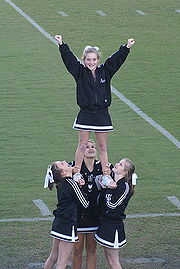
Cupie or Awesome : The Cupie is almost identical to the Full Extension except that the flyer's feet are together, in one hand of a single base or with one foot each in the hands of two bases. In a partner stunt the difference between a cupie and an awesome has to do with what the male is doing with his free hand. If the free hand is on the hip then it is a cupie, if the free hand is in a high V then it's an awesome.
Extension : Flyer stands with each foot in the hands of a base while her arms are in an extended overhead position. The back can either hold the ankles of the flyer, or support the wrists of the bases if it's legal by your state's rules. In a single based stunt, the base will hold both of the flyer's feet above his/her head, with arms locked.
Split-lift or Teddy Sit: The flier is in a seated straddle with one base holding each leg and the backspot holds the same way as a sponge.
Thigh stand : A Thigh Stand is one of the simplest stunts. The bases kneel on one leg or are in a lunge position. The bases have their feet touching each other by the sides of their shoes. The back spot will hold the flyer at the waist. She will then jump onto the bases thighs.
Variations
All of the variations can be done at prep or extension level.Liberty (Lib) : One or more bases holds up the flyer by the standing foot (usually the right foot) and the flyer balances weight on the standing leg. The flyer's other leg is bent at a 90 degree angle, and the toe is pointed and touching the right knee. This stunt if named for the way it looks similar to the Statue of Liberty. The name of this stunt is often shortened to 'Lib'.
One man : The base is in a middle squat position and the flyer walks up on her thigh and puts her legs on her shoulders and the back spot grabs her waist while the front spot helps her stand up on the bases (keep in mind that when the flyer stands up the back-spot grabs her ankle)shoulders and when the flyer has stood up for a while the bases pushes the flyer off her shoulders and turns her body and the front spot quickly moves and stands on the side of the flyer and the base and front spot put there hands out catching the flyer and the back spot puts her arms under the flyers under-arms
Scorpion : One or more bases holds up the flyer by the right foot and the flyer balances weight on that right straight leg. The flyer then grabs the loose foot and bends that leg upward behind the body until the toes are close to the back of the head, in a position resembling a scorpion's tail. The foot is secured in place by the opposite hand. A more advanced variation of the scorpion is the "Chin-hold," where the flyer tucks her foot underneath her own chin and holds.
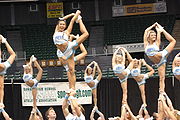
Scale : One or more bases extend right foot. The flyer's other leg is held by his/her hand to the side and the leg is fully extended. The position is similar to the Scorpion, but one of the flyer's hands holds her ankle or calf (instead of her toes) and the other arm is in the High V position. Sometimes also called a 6 o'clock, or needle.
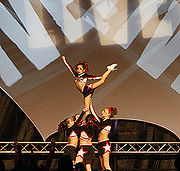
Heel Stretch : It is a stunt in which the base/bases holds one foot of the flyer while she holds the other foot in her hand and brings it beside her head.
Bow and Arrow: Variation of a heel stretch. The flyer grabs her left foot with the right hand, and pulls her leg straight up beside her head. Then she pulls her left arm and upper torso through the hole the leg and arm made, holding it straight.
Cobra : Variation of a bow and arrow. With the left foot still held by the right hand, the flyer wraps her left arm around her leg so her hand is behind her head. Then she grabs her left hand with her right hand, pulling her straight leg closer to her face.
Needle : Variation of liberty facing a regular scale and a needle is the flyer's position in the air. Where in a normal scale the chest is either parallel or higher than the hip on the supporting leg, a needle scale the chest is down beside the main support leg. Also, the leg that was supported by hands in a regular scale is now "free" and is pointing to near as north or "12 o'clock" as flexibility allows the flyer to obtain. The flyer also maintains balance by holding onto the bases hands and her own ankle.
Arabesque : From a lib, the flyer points their leg out behind them and their arms are in a "T" position.
Hitch : A hitch is a variation of the prep or extension. Usually in a pyramid. 3-5 people in a hitch pyramid. The two out-side flyers are uaully on one girls shoulders (Shoulder sit.) the two middle flyers are in an extension and give there left or right foot (depending which side)to the girl in the middle who holds the feet by her shoulders.
No-hands/Chin Chin : When the flyer takes her foot and bends it under her chin and it sits there with no-hands
Running Table-top : When 4 flyers are bent over with a flat back like table-tops and the other flyer that is in a half quickly runs across there backs and goes into a half on the other side
Bicycle : The base lifts the flyer onto his palm which he extends upwards into a Statue of Liberty position. She sits on his palm while he holds the ankle of one leg against his chest with his other arm. The flyer stunts with her arms and free leg.
Transitions, Tosses, and Dismounts
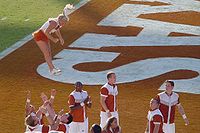
- Basket Toss variations include:
Straight ride, a basket toss where the flyer ride up to the top and comes back down without any lines. simple :*Toe Touch basket toss - During the basket toss, when the flyer i she stays in the "pencil" position. once starting to fall, she does the toetouch jump, quickly pops back into pencil, and then into the cradle.
- Pretty Girl/Show off basket toss - When in the air, the flyer will do her legs like in a lib[erty] and put one hand on her waist and one behind her head, laying down.
- Kick twist basket toss - At the height of the basket before falling, the flyer will kick one leg up then twist her body into a cradle. The flyer may twist up to two times.
- Pretty Girl Kick Twist bsket toss - During the ride the flyer does the pretty girl and at the height of the basket performs the kick twist.
- Tuck basket toss - while in the air the flyer will perform a tuck (front or back) then pop into cradle.
- X-out basket toss/X-Full - same as tuck basket toss, but while upside down in the tuck the flyer will perform the jump "spread eagle" which will make the body look like a X.
- Pike basket toss - same as toetouch basket toss but the flyer will perform a pike.
- Star basket toss - in the air, once starting to fall, the flyer will put a leg up like in a scale, and the other will be straight facing diagonally downward. the hands will be in a high V, then she'll pop back into pencil. In some variations, the flyer will spin while in the Star jump.
Ball Up: The bases launch the flier in the air. She stays in a ball until she hits her peak, and stands up in a one leg extension. These are commonly followed by a tick tock.
Launch or Smush Toss: Almost like a basket toss except hands are in formation of a prep or extension.
Pop Cradle or Cradle Down : Dismount from a stunt in which the base/bases toss the flyer straight up from a stationary stunt then catch the flyer in a seated position pike position.
Dismount : A way to return the flyer to the floor or complete a stunt.
Squish (or Sponge or Smush) : Two bases will each hold a different foot of a flyer at their waist level. The flyer is squatted down so the flyer is not taller than the bases. This is how the flyer loads in to the stunt, before jumping and pushing off the bases shoulders, and the bases drive their arms upwards and extend the flyer.
Retake : When a stunt is extended in the air, and then goes back down into a load-in position placing both feet in the bases hands, if previously in a one-footed stunt.
Show & go: Kind of like a retake, where the bases, put their flyer straight up into a full, and go straight back down into scrunch.
show & go full: The same as the show & go, exept instead of going to a scrunch at the end, you either go into a half, or a full.
Chair: When one base starts a flyer at an angle and pushes her up with one hand and holds her in there hand for one 8 count
Yoyo or Double Take: Like a retake but the flyer goes straight back into another stunt.
Show and Go : Two bases will each hold a different foot of a flyer and bring it up to a full extension. The flyer only stays up for two counts and returns back into a squish position. Also known as 'fake-outs' or 'flashes'. Depending on the stunt, the flyer can throw any number of tricks in a show and go. If loading in with both feet, most times the flyer will "show" a cupie, and after reloading, come back up to a cupie in either a prep or extension level. Another variation is the one-legged show and go, where a flyer starts as if in a one-legged stunt, and "shows" one leg kicked up to the heel stretch position (without grabbing the ankle or instep). As this variation is brought back down, the flyer brings in her leg from the flash and reloads in either a two or one legged sponge, "going" back up to prep or extension level.
Rainbow : Like a Show and Go but when reaching the top the flyer arches her back sending her backwords and the bases move to catch her.
Tick-Tock : When a flyer switches the foot being stood on in mid air after being popped by bases.
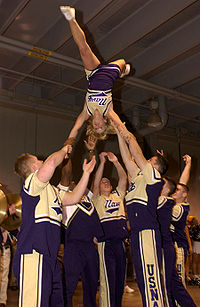
Double Down (Double Twist Cradle) : Variation on a pop cradle. The same as a full twist cradle, but two 360 degree turns are completed before cradling. There are also increasing numbers of twist downs possible, often as many as five, witnessed especially when four males are basing a basket toss, however no more than two twists are allowed in competition at any level.
Leap Frog or popcorn : Usually a transition where the bases "hop" top person over the backspots head and catch her in either a smush or cradle.
Reload : A transition that connects two stunts when a flyer cradles out of the first stunt, and the bases dip and pop the flyer back into a load position. A similar stunt is a barrel roll. Sometimes called a 'cradle pop'.
Barrel Roll : Seated in a pike position, (as if she had just cradled down) the bases toss the flyer, she lays flat and does a 360 degree spin in the air.
Full up : A variation on the double take in which the flyer does a full turn in the air to the right in between stunts while staying in contact with the bases. Also called a 360 up in some regions.
Double up : The more advanced version of the Full up where two complete 360 degree turns are made
Rewind : An advanced stunt load where the flyer is tossed into the air by her base/bases, she then does a back tuck and brings her feet in contact with her base/bases
Walk Down : A dismount where the flyer does a full turn to the left in a standing position while having her right foot in contact with the bases.
Deadman : When the flyer falls backwards or forwards out of a stunt where 3 or 4 people catch the flyer and could possbly push the flyer back up to the bases hands.
Swedish Falls : Center bases face each other, legs shoulder width apart, arms straight and hands on each other's shoulders, a flyer stands behind each base, facing the bases' backs. Flyers place hands on bases' shoulders, each flyer has a second base. These bases squat in between the other base and the flyer. They hold the flyers' waists, third base holds the flyers upstage leg—one hand on her thigh and the other on her ankle.
- On 1, 2, down, up, the flyer bends her knees and jumps. The second and third bases lift the flyer up, fully extending their arms. The flyer's arms are also fully extended. The center bases have the flyers' weight on their shoulders. They support each other to maintain balance. Both flyers lift their downstage leg (the base is only holding the upstage leg). The second and third bases lower the flyer on the dismount.
Two-and-a-half High Stunts

- The A-Frame
- Swedish Fall
- 2-2-1
- 2-1-1 (Technically a 3 high pyramid if the top flier is in an extended stunt but still considered legal)
- Table Top
- Wolf Wall
- High Split
- High Chair (also high hands, lib, cupie, etc.)
lost bug
change fall
bascet fall
wheel chair

